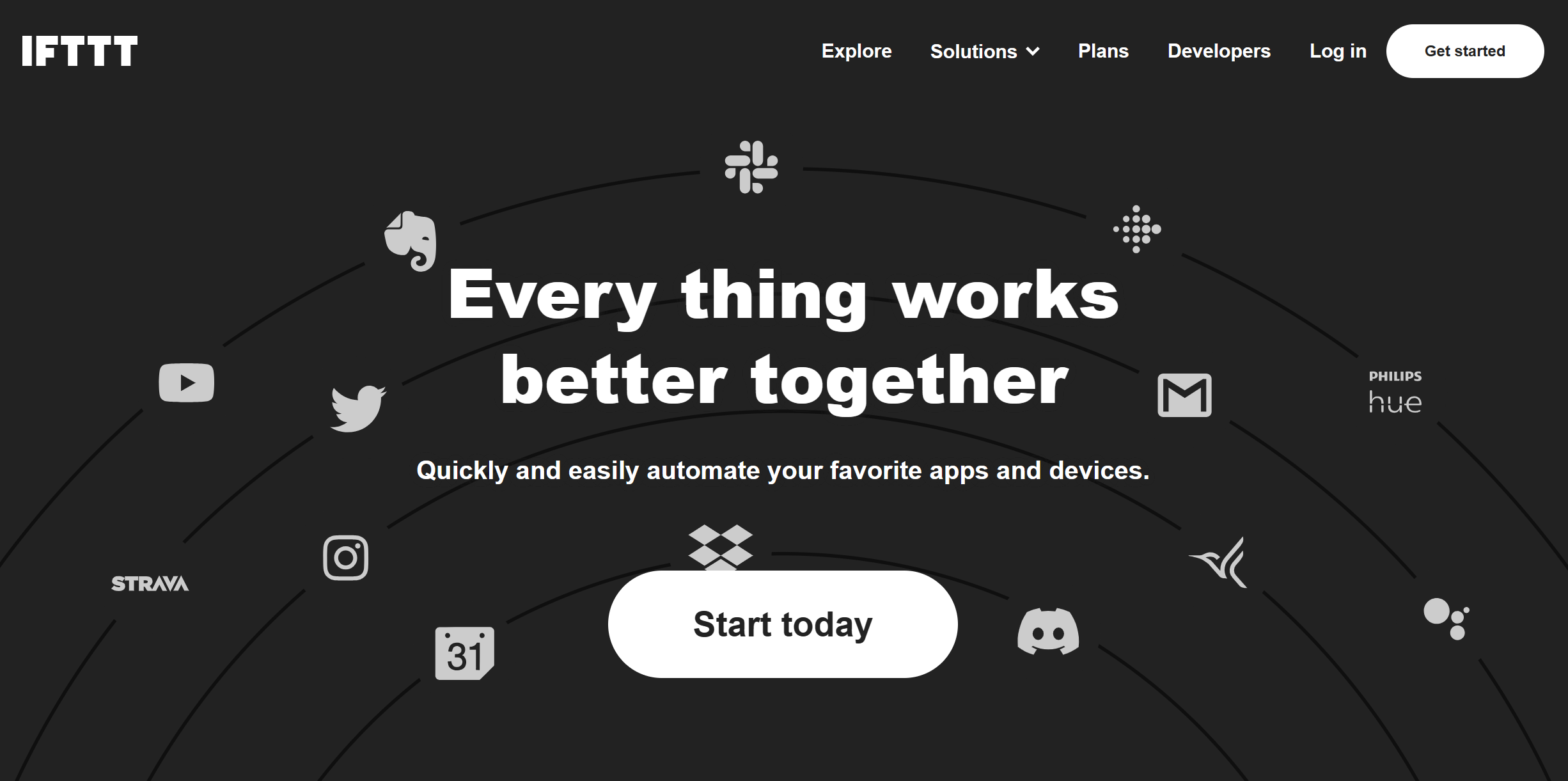If you happen to start marketing your business online, you likely have heard the term ‘Cost Per Mille’ (CPM) thrown around quite a bit. It can be confusing to understand what this means and how it applies to the marketing landscape surrounding your business and its goals.
Essentially, CPM stands for 'Cost per thousand,' and is used as a way to gauge how much a marketing campaign is costing per one thousand impressions. So why isn't it called 'CPT' then? Like many things in the English language, this acronym was adopted from the Latin word for thousand, which is 'mille.'
Before we start, we would like to introduce IFTTT, which is our automation service that can make marketing your next big idea a breeze. With this platform, marketers can set up CPM campaigns and get the most out of their budget by making sure they are hitting the right target audience with each campaign.
Now that we understand why it is called CPM, and have a basic understanding of what it represents, it's time to dive deeper. So, let's get right into what CPM stands for and how it is used in marketing today.
BTW IFTTT is free to join and you can automate your Google Ads and Facebook Ads.
Understanding Digital Marketing Metrics

A brief discussion on key metrics used in digital marketing is essential to understanding how CPM works. The three most commonly used metrics are Cost Per Click (CPC), Cost Per Acquisition (CPA), and Return On Ad Spend (ROAS). By combining these three together, marketers can truly understand the potential of their campaigns and decide which strategies would be best suited for their needs.
Cost Per Click (CPC): CPC is the cost associated with a single customer clicking on an ad to reach your website. This metric is often used when tracking campaigns that are focused on driving traffic to a specific page or product.
Cost Per Acquisition (CPA): CPA is similar to CPC, but the key difference is that it measures the cost associated with acquiring a customer. This could include things like a sale, signup, or download. CPA is a great way to gauge how well your advertisements are convincing customers.
Return On Ad Spend (ROAS): ROAS is the direct result of the above mentioned metrics and serves as an indication of how effective the campaigns are. This metric will provide insight into which strategies are working best for your business by showing how much income you make in comparison to your ad spending.
Defining CPM: Cost Per Mille

Cost Per Mille (CPM): CPM, or Cost Per Mille, refers to the expense an advertiser incurs for every 1,000 impressions of their advertisement. An impression is counted each time an ad is displayed, regardless of whether it is clicked on or not.
This metric enables advertisers to measure the cost-effectiveness and potential reach of their campaigns. CPM is especially relevant for campaigns focused on raising brand awareness or visibility, since the goal is to be seen by as large an audience as possible.
It's crucial to remember that while a higher number of impressions might lead to increased visibility, it does not directly correlate to engagement or conversions, which are measured using other metrics like CPC and CPA.
How is CPM calculated?

Calculating CPM is relatively straightforward. Here is a step-by-step guide to help you through the process:
Determine the total cost of your advertising campaign: This is the total amount of money spent on a specific advertising campaign.
Identify the total number of impressions: This is the total number of times your ad was displayed, regardless of whether it was clicked on or not. Remember, an impression is simply a measure of the number of times your ad was seen, so if your ad was displayed 5000 times, you have 5000 impressions.
Convert the number of impressions to 'per thousand' impressions: Because CPM is calculated per thousand impressions, you’ll need to divide your total impressions by 1000. So, if you have 5000 impressions, you would get 5 (5000/1000).
Calculate CPM: Now, you can calculate your CPM by dividing the total cost of your campaign by the number you got in step 3 (impressions per thousand). For example, if your campaign cost was $1000 and you got 5 from step 3, your CPM would be $200 ($1000 / 5).
Remember, CPM is a useful metric for understanding the cost effectiveness of your ad campaigns, especially those focused on increasing brand visibility. However, it should be used in conjunction with other metrics like CPC, CPA, and ROAS for a holistic understanding of your digital marketing performance.
CPM vs. other advertising models

When tracking the performance of your campaign, it is useful to view all of the metrics discussed above. However, depending on which platform you choose, payment for the ads can come in many forms. Should I choose a plan that lets me pay per impression, or maybe should I pay per click?
Not all advertising platforms, such as Google Ads, offer multiple ways to pay for your ads. Regardless, we will still cover the pros and cons of each method as it can be a major factor in which platform you choose to advertise with.
Cost Per Mille (CPM)
Pros: - Ideal for increasing brand exposure as it guarantees a number of impressions. - Easier to budget as you pay a fixed amount per thousand impressions.
Cons:
- Doesn't guarantee engagement or conversions.
- May not be cost-effective if your ads aren't well-targeted.
Cost Per Click (CPC)
Pros:
- You only pay when someone clicks on your ad, indicating interest.
- Can be more cost-effective if your ad leads to high conversion rates.
Cons:
- Costs can quickly add up if many users click but don't convert.
- Requires careful keyword and demographic targeting to ensure clicks are from potential customers.
Cost Per Action (CPA)
Pros:
- You only pay when a user completes a desired action, like making a purchase or signing up for a newsletter.
- Lower risk as payment is tied to specific results.
Cons:
- Typically more expensive per action compared to other models.
- Requires a high-converting landing page and effective sales funnel.
In summary, each model has its strengths and weaknesses. The best choice depends on your specific campaign goals, budget, and capacity to track and analyze results.
Maximizing your CPM: Tips and tricks

Getting the most value out of your Cost Per Mille (CPM) advertising involves a few critical strategies. Here are some tips and tricks to help you optimize your CPM for better campaign results:
Targeting: One of the most effective ways to maximize your CPM is by improving your targeting. This means focusing your ads on the audiences that are most likely to be interested in your product or service. Using demographic, psychographic, geographic, and behavioral data can help you refine your target audience.
High-quality creative works: Ensure your ads are visually appealing and engaging. High-quality design and compelling copy can increase the chances of viewers interacting with your ad, resulting in a higher CPM.
Testing and optimization: Regularly test different versions of your ads to see which ones perform best. This could involve trying unique headlines, images, or calls to action. Use the insights gained from these tests to continuously optimize your ads.
Use video content: Video content tends to have higher engagement rates than static images or text. If appropriate for your brand and audience, consider investing in video advertising to potentially boost your CPM.
Advertising made easy with IFTTT
In order to have your ads reach hundreds of thousands of viewers, it takes diligent work day after day. Whether it be testing new keywords, designing ad creatives, or tracking metrics, the task of advertising is often spread between huge teams of experts.
No need to worry if you don't have a corporate office full of sales reps, just try IFTTT. Our service stands for 'If This Then That' and is a tool that automates simple tasks such as scheduling ads, tracking metrics, and sending notifications.
Whether you're in the beginning stages of launching your first ad campaign or expanding into other markets, IFTTT helps make it easy to manage your advertising campaigns efficiently and cost-effectively. IFTTT offers integrations between over 800 different apps and services, and users can browse millions (yes, millions) of community-made automations.
Best Applets for advertising support

IFTTT offers various Applets that can help make your life easier when it comes to running ads. Here are a few of our top recommended Applets for marketing and advertising professionals:
These are just some of the options available to you with IFTTT. Try out our Applets today for free and see what IFTTT can do for your advertising campaigns!


